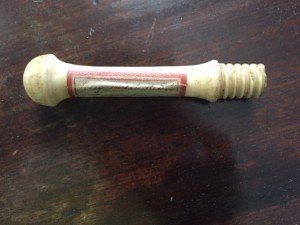A Simple Coat Peg Tells a Story of Nantucket’s Tinsmith
This was previously published in Yesterday’s Island
this summer and on my Nantucket Chronicle
column, “The Nation of Nantucket.” If you keep up with “Maria Mitchell’s Attic,” then you should know who Peleg Mitchell Junior is!
It’s small, oddly shaped, has a screw-like quality at one end and a rounded nub at the other, and has a red and white gummed label adhered to it. People often ask, “What is that?” as they peer into the case to see some of the smaller items in the Mitchell House collection.
“That, is Peleg Mitchell’s coat peg,” we answer. Who is Peleg Mitchell and why do we have his coat peg? Peleg Mitchell Jr, like Maria Mitchell herself, was the youngest of ten children born to Peleg Mitchell Sr and his wife, Lydia Cartwright Mitchell in 1802. Peleg Mitchell Jr (Peleg) lived at 1 Vestal Street after Maria Mitchell’s family moved to the Pacific National Bank when she was 18. Her father, as bank cashier, was in charge of the entire bank and housing above the bank came with the position. Thus, when they moved out, William sold the home at 1 Vestal to his youngest sibling, Peleg; the MMA has the original bill of sale.
Peleg was a tinsmith. In fact, he and his partner James Austin were the only tinsmiths practicing at the time so they had a very busy shop. Think of tinware, in part, as the Tupperware of the time – tin was used for all sorts of things – lanterns, candleholders, food containers, colanders, graters, lanterns, boxes . . . it was fairly cheap, easy to fabricate quickly, and just plain ubiquitous. Peleg was a leader within the Friends (Quaker) meeting and with the schisms that occurred in the faith, he would become a Wilburite while his older brother William would become a Gurneyite. As a leader within the meeting, Peleg also hosted some smaller meetings at the house at 1 Vestal Street in the front sitting room. One of his (probably) many tinsmithing apprentices was one of his nephews, William Forster Mitchell, Maria’s younger brother. This tinsmithing background would help – in part – Forster (as he was referred to) assist in the founding of the Industrial Arts Department at Howard College – Howard University today – in Washington, DC. He and his Uncle Peleg must have been close after this apprenticeship as they also corresponded quite a bit when Forester was the superintendent of Haverford College. Their letters can be found in the Haverford archives – it was founded as a Quaker school.
Back to the coat peg. It is small object – but one of many that the MMA has in its collection at the Mitchell House that belonged to the family. Made of whalebone, it likely screwed into a panel somewhere in the house that was strapped to the plaster – serving as a special coat hook just for Peleg. The large gummed label was unfortunately but likely done in the early part of the twentieth century so that it wasn’t misplaced or someone in the family did not forget what it was and to whom it belonged. In any case, it was cataloged as part of the collection in the 1950s. The donor is unknown which may mean that it drifted about the 1 Vestal Street house a bit; the house became a museum in 1903 coming to the MMA directly from the family so anything that was in the house from Peleg’s and his wife’s time in it simply remained. I have a feeling this might have been still in its place in the wall into the 1950s before someone chose to remove it for safekeeping maybe while some conservation work was being done or so that someone didn’t paint over it or forget what it was and to whom it belonged.
JNLF
Recent Posts





